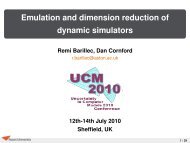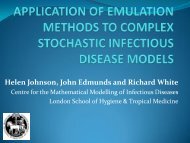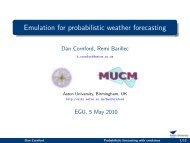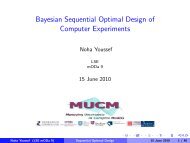Projected Sequential Gaussian Processes: A C++ tool for ... - MUCM
Projected Sequential Gaussian Processes: A C++ tool for ... - MUCM
Projected Sequential Gaussian Processes: A C++ tool for ... - MUCM
Create successful ePaper yourself
Turn your PDF publications into a flip-book with our unique Google optimized e-Paper software.
<strong>Projected</strong> <strong>Sequential</strong> <strong>Gaussian</strong> <strong>Processes</strong>: A <strong>C++</strong> <strong>tool</strong> <strong>for</strong> interpolation of heterogeneous data sets 8<br />
set AS = {x1,...,xm} of m locations where typically m ≪ n. Since psgp computation<br />
scales cubically with the size of the active set, m should be chosen as small as possible,<br />
however there is clearly a trade-off, which is discussed later. Computation of the parameters<br />
of the posterior parametrisation (the vector α and the matrix C) is a challenging task<br />
<strong>for</strong> a number of reasons. The parametrisation is an approximation that is based on the<br />
active set. Optimal active set locations depend on covariance function model parameters<br />
hence as these are re-estimated the active set must be reselected. The algorithm runs<br />
<strong>for</strong> a number of cycles and the processes of active set selection and covariance model<br />
parameter estimation are interleaved obtaining improved estimates during each cycle.<br />
Using the parametrisation from (3) and (4), the update rules are written as:<br />
αt+1 =αt + q+ st+1<br />
Ct+1 = Ct + r+ st+1s T t+1<br />
with st+1 = Ctct+1 +et+1 (5)<br />
where ct+1 = [c0(xt+1,x1),...,c0(xt+1,xt)] T is the prior covariance between the location<br />
being considered at iteration t + 1 and all current points in the active set. et+1 =<br />
[0,0,...,1] T is the t + 1-th unit vector that extends the size of αt+1 and Ct+1 by one. The<br />
consequence of the update rule is that: (1) all locations need to be processed since all of<br />
them contribute to the resulting mean and covariance functions, and (2) the contribution<br />
of each observation is retained in the posterior parametrisation.<br />
The benefits of the parametrisation and the sequential nature of the updates are two-fold.<br />
First, the update coefficients (q+ and r+) can be computed <strong>for</strong> a variety of user-defined<br />
likelihood models, pi(yi| f ,xi,hi), as shown in Section 4.1 and secondly, the update coefficients<br />
can be computed in a manner which does not require that the model complexity<br />
to be increased, as shown in Section 4.2.<br />
4.1 Computing the update coefficients<br />
The update coefficients, q+ and r+, can be computed in two main ways. Essentially<br />
these update coefficients can be seen as computing the first two moments of the updated<br />
<strong>Gaussian</strong> approximation at xt+1, and thus require the evaluation of integrals. In Csató<br />
and Opper (2002) analytic <strong>for</strong>mulations <strong>for</strong> q+ and r+ are given <strong>for</strong> <strong>Gaussian</strong>, Laplace<br />
and one sided exponential noise models. Within the psgp package at present only the<br />
<strong>Gaussian</strong> noise model is implemented analytically. In this paper we extend the updates<br />
to include a sampling based strategy, since the presence of a non-linear sensor model, h,<br />
will almost certainly make analytic updates impossible.<br />
The update step is iterated several times, within an inner loop to process all observations,<br />
and within an outer loop to recycle over data orderings, as shown in Algorithm 1. It is<br />
thus important that the computation of q+ and r+ is as efficient as possible. The sequential<br />
nature of the approximation means that the required integrals are low dimensional, and <strong>for</strong><br />
scalar observations, one dimensional. Several methods might be envisaged, ranging from<br />
quadrature to Markov chain Monte Carlo methods. The selection of Population Monte<br />
Carlo (PMC) sampling (Cappé et al., 2004) was based on its simplicity and efficiency.<br />
PMC is a sequential importance sampling technique, where samples from one iteration<br />
are used to improve the importance sampling, or proposal, distribution at the subsequent<br />
steps in the algorithm. The technique is known to be efficient and we have found it to be<br />
stable too.<br />
The basic implementation is summarised in Algorithm 2. The main benefit of this approach<br />
is that one only needs to evaluate the sensor model <strong>for</strong>ward to compute the likelihood<br />
of the observation p(yi| f ,xi,hi) and thus we can supply h as a MathML object to






